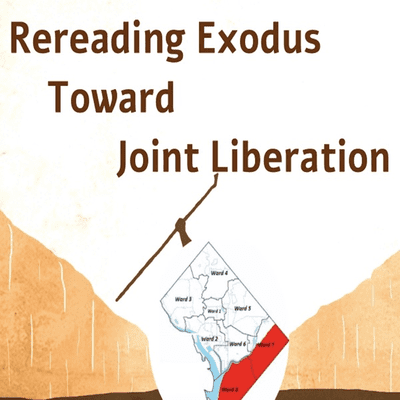
Rereading Exodus for Joint Liberation
Podcast von Rereading Exodus for Joint Liberation
Nimm diesen Podcast mit

Mehr als 1 Million Hörer*innen
Du wirst Podimo lieben und damit bist du nicht allein
Mit 4,7 Sternen im App Store bewertet
Alle Folgen
6 FolgenThis week’s reading, Mikeitz (Gen 41:1-44:17), comes to us from several different perspectives. In addition Rabbi Suzanne Singer notes the cliffhanger nature of this telling, describing it as a reminder to us that “…our choices are moment-to-moment decisions, the path never certain until the time comes to act. This cliffhanger ending is also a signal of hope, because teshuvah [return, repentance] is always open to us” (final paragraph here [https://www.myjewishlearning.com/article/healing-transformation/]). These two narrative devices — use of different perspectives and the cliffhanger — have crucial relevance to events in DC this past weekend and to the threat ahead: The time to act is always before us, and taking into account the perspectives of those most affected is essential in decision-making. Please visit December 2020 in DC [https://crossriverdc.net/december-2020-in-dc/] for background on events this past weekend from a variety of perspectives.
In this week’s portion, we read about an incident involving Potiphar, Potiphar’s wife (never named in the Torah), Joseph, who is enslaved within Potiphar’s house, and other menservants of the household. Nechama Leibowitz points out how Potiphar’s wife uses different language when telling the servants her story and when telling her husband: this reflects an attempt to use servant/noble class consciousness to create common cause, however temporary, Leibowitz argues. This week’s portion is Vayeishev, Genesis 37:1 – 40:23. More about Nechama Leibowitz (1905-1997) at Jewish Women’s Archive [https://jwa.org/encyclopedia/article/leibowitz-nehama].
In this week’s Torah reading, we see that Dinah goes out “to see.” What does it mean for an individual of one culture or community “to see” someone from another? What can and can’t we see? This is episode 8 in Genesis. Vayishlach is Genesis 32:4-36:43. What follows is Hebrew for verse 34:1, transliteration, and some translations, followed by commentary. [https://i1.wp.com/rereading4liberation.com/wp-content/uploads/2020/12/Genesis-341.jpg?resize=484%2C98&ssl=1]transliteration: Vatetse Dinah bat-Leah asher yaldah le-Ya’akov lir’ot bivnot ha’arets. (borrowed from Bible.ort.org [http://bible.ort.org/books/torahd5.asp?ACTION=displayid&id=982], which also offers other formats; or see mechon-mamre.org [https://www.mechon-mamre.org/p/pt/pt0134.htm]) SOME TRANSLATIONS: And Dinah the daughter of Leah, whom she had borne unto Jacob, went out to see the daughters of the land. — JPS 1917 (via Mechon-Mamre.org) Now Dinah, the daughter whom Leah had borne to Jacob, went out to visit the daughters of the land. — JPS 1985 (via Sefaria.org) Dinah, Leah’s daughter, who was born to Jacob, went out to look at the women of the land. — Targum Onkelos (Geffen, 2006) Now Dinah — the daughter of Leah, whom she had borne to Jacob — went out to look over the daughters of the land. — Scherman (Stone/Artscroll, 1993) Dina, Lea’s daughter, whom she had borne to Yaakov, went out to see the women of the land. — Fox (Schocken, 1995) And Dinah, Leah’s daughter, whom she had borne to Jacob, went out to go seeing among the daughters of the land. — Alter (Norton, 1996) COMMENTARY Targum Onkelos commentary: Scripture mentions Dinah’s parents in this narrative with beautiful symmetry, but Rashi and Nachmanides do not focus on the poetic methodology and find special meanings here. Rashi contends that the words “daughter of Leah” instead of “of Jacob” is intended to remind us that Leah was also accustomed to going out, as the Bible states, “Leah went out to meet him” (30:16); thus, “like mother, like daughter” (Ezekiel 16:44). Nachmanides suggests that the reference to Leah foreshadows that other children of Leah will avenge Dinah’s defilement (in verses 25-31). Arnold B. Ehrlich (Mikra Ki-Pheschuto, 95) proposes that this episode is recorded in Scripture to emphasize how much the patriarchs did not want to intermarry with the Canaanites. He also notes that this episode could not have occurred when Jacob was returning from his stay with Laban because Dinah was only about four years old at that time (p.445 [additional note follows]) Additional note By its clear statement that Dinah left to look at the women, Scripture is informing us that she had no intention of becoming embroiled with Shechem (ibn Kaspi). However, Neophyti and Genesis Rabbah feel she acted improperly. The former writes that she went out with the intention of letting herself be seen with the other women by the men, and the latter claims that she provoked the incident by allowing Shechem to see her exposed arm. ——- Artscroll commentary: The daughter of Leah. Because Dinah went out — in contradiction to the code of modesty befitting a daughter of Jacob — she is called the daughter of Leah because Leah, too, was excessively outgoing [see above, 30:16]**. With this in mind, they formuluated the proverb, “Like mother like daughter” (Rashi). Even though the Sages teach that Dinah was lured out of the house, this implied criticism is valid, for she would not have gone if it had not been natural for her to be too extroverted. She is also called the daughter of Jacob (vs 3,7), because his distinguished reputation [in addition to her great beauty (Radak)] influenced Shechem to covet her (Or HaChaim). [for more on Or HaChaim, see below] **Genesis 30:16 Text: When Jacob came from the field in the evening, Leah went out to meet him and said, “it is to me that you must come for I have clearly hired you with my son’s dudaim.” So he lay with her that night. Commentary at 30:16 Leah went out. The Sages viewed this unfavorably, as an immodest act, and because of it, the Midrash describes Leah critically as a [y’tzanit], “one who is fond of going out.” See Rashi to 34:1. ——- Fox commentary to see: To visit. ——- Alter commentary to go seeing among the daughters of the land. The infinitive in the Hebrew is literally “to see,” followed not by a direct object, as one might expect, but by a partitive (the particle be), which suggests “among” or “some of.” Although the sense of the verb in the context may be something like “to make the acquaintance of” or “travel around among,” the decision of several modern translations to render it as “to visit” is misconceived. Not only does that term convey anachronistica notions of calling cards and teac, but it obliterates an important repetition of terms. This is one of those episodes in which the biblical practice of using the same word over and over with different subjects and objects and a high tension of semantic difference is especially crucial. Two such terms are introduced in the first senence of the story: “to see” and “daughter.” Dinah, Jacob’s daughter, goes out among the daughters of the land, an identity of terms that might suggest a symmetry of position, but the fact that she is an immigrant’s daughter, not a daughter of the land, makes her a ready target for rape. (In the Hebrew, moreover, “sons” and “daughters,” banim and banot, are differently inflected versions of the same words, so Dinah’s filial relation to Jacob is immediately played against Shechem’s filial relation to Hamor, and that in turn will be pointedly juxtaposed with the relation between Jacob and his sons). Shechem’s lustful “seeing” of Dinah is immediately superimposed on her “seeing” the daughters of the land. ——- DINAH’S SILENCE OUR DAUGHTERS ASK: Why are we told so little about Dinah?… DINAH ANSWERS: Because from the moment of my birth, I was fated to remain silent. In fact, in the entire Torah, I never speak a single word. When I was born, my name, unlike my brothers’, was announced withotu interpretation. When I was raped, my cries went unrecorded. When my brothers negotiated with Hamor for my hand, my wishes were not considered. And when my father, Jacob, bestowed his blessings upon his children, I received none. That was why I visited the Canaanite women. Utterly invisible at home, I craved attention and went out looking for it. Only too late did I learn that neglect is not the only injury a woman can suffer. — The Five Books of Miriam: A Woman’s Commentary on the Torah. Ellen Frankel, ed. (Harper Collins, 1996), p.65-66 Or HaChaim via Sefaria Dinah, Leah’s daughter went out, etc. The reason that the Torah emphasises that Dinah was Leah’s daughter (something that we are well aware of) is in order to facilitate understanding of the causes underlying Dinah’s excursion into town. There were three reasons for this. 1) Dinah was Leah’s daughter. Had she been Rachel’s daughter she would never have made such an unchaperoned excursion. Her mother Leah had “gone out” to meet her husband (30,15), something that was uncharacteristic of Jewish women. Bereshit Rabbah 80,1 claims that at the time Leah adorned herself with all her jewelry. Her daughter copied her mother, giving the impression that she was a harlot. 2) A second cause for Dinah’s excursion was the fact that as an only daughter she had no female playmates; she went in search of suitable company. Inasmuch as she was a daughter of Jacob she had already acquired the reputation of being a distinguished person, something that provoked Shechem as we shall explain later. 3) לראות בבנות הארץ, “she went to take a look at the daughters of the land.” According to Pirke de Rabbi Eliezer chapter 38 Shechem had brought the girls of the neighbourhood to play music around the tent of Jacob. This then was a third reason for Dinah venturing outside. From all the above you may surmise that unless Shechem had already been aware of the existence of Dinah, a daughter of the famous Jacob, even before she left her house he would not have committed the rape. Or HaChaim was composed c.1718-42 CE by Rabbi Hayyim ben Moshe ibn Attar (1696-1743). Rabbi Hayyim was a Moroccan Kabbalist and Talmudist.
A few thoughts on diversity of place names, names for the divine, and ways of calling on, clinging to, and claiming land in this week’s Torah reading. The portion is called Vayeitzei [And he left/went out], Gen 28:10-32:3 NAMING LAND, NAMING ANCESTORS: GENESIS Genesis 31:47: > Laban named it Yegar-sahadutha, but Jacob named it Gal-ed. Dictionary notes on the two names: Yegar-sahadutha [Aramaic] = “witness heap” * the mound of stones raised as witness between Jacob and Laban, called by Jacob in Hebrew ‘Galeed’ Galeed [Hebrew] = “witness heap” * the pile of stones heaped up between Jacob and Laban to certify their covenant; located on Mt Gilead The close of Laban’s parting speech, Genesis 31:53: > …May the God of Abraham and the god of Nahor”—their ancestral deities—“judge between us.” And Jacob swore by the Fear of his father Isaac. NAMING LAND, NAMING ANCESTORS: WASHINGTON DC National Park Service brief history of Nacotchtank/Anacostan land [http://National Park Service https://www.nps.gov/articles/native-peoples-of-washington-dc.htm] Piscataway Conoy tribe site [http://www.piscatawayconoytribe.com/history.html] Land Acknowledgement of Hill Havurah, on the west side of the Anacostia River. Land-Acknowledgement-with-map-and-note [https://rereading4liberation.com/wp-content/uploads/2020/11/Land-Acknowledgement-with-map-and-note.pdf]Download [https://rereading4liberation.com/wp-content/uploads/2020/11/Land-Acknowledgement-with-map-and-note.pdf]Historic Anacostia (DC Cultural Tourism [https://www.culturaltourismdc.org/portal/991]), Go-Go Museum/Cafe [http://gogomuseumcafe.com/] in development Anacostia Unmapped [https://wamu.org/story/16/05/11/anacostia_unmapped_the_nacotchtank_and_the_first_gentrifier/]: The Nacotchtank And The First Gentrifiers
Episode 6, based on the Torah portion Toldot, Gen 25:19-28:9. Two not thoughts on Esau and Jacob. “The Greatest Threat to Civilization… [https://reformjudaism.org/learning/torah-study/torah-commentary/greatest-threat-civilization-taught-torah]” by Rabbi Michael Dolgin, citing Pardes Yosef from the Lodz Ghetto. See also Avivah Gottlieb Zornberg. Genesis: The Beginning of Desire (Jewish Publication Society, 1995). Get a copy, if you can — or read some of it on Google Preview.























